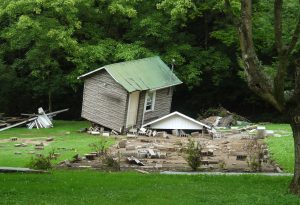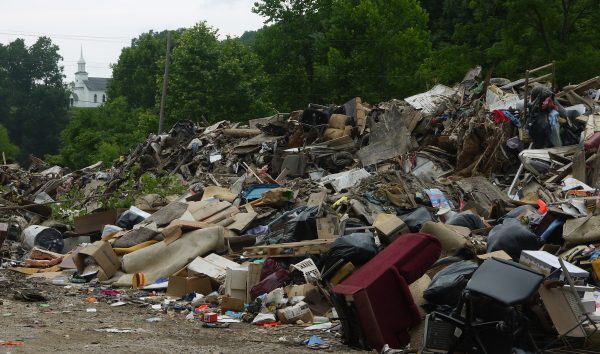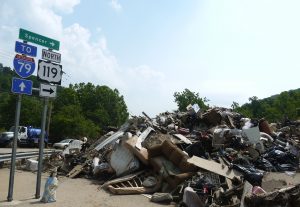In late June, clouds settled over the mountains of West Virginia, and rain began. At first, this seemed like a normal summer storm system, but quickly state news channels began to broadcast reports of flooded communities. In some locations, more then ten inches of rain fell in less than a day!
Anyone who knows anything about WV topography knows that many of our communities are located in narrow river or creek valleys, in between the lush and beautiful mountains that interconnect across the Appalachian mountain chain. We are located in what is referred to as a “temperate rain forest region,” the second most diverse such region on the planet. Our intact mountains, forests and streams can actually serve as a sponge during normal summer storms, absorbing and filtering a lot of water.
This, however, was no “normal” rain event. This was especially true in the community of White Sulphur Springs, WV, where normally small and tranquil trout streams quickly swelled and converged into a torrent that looked more like the muddy Mississippi river! Unfortunately, many homes were in the flooded valleys and many people, state-wide, lost everything, including 23 that lost their lives. In multiple other communities, homes, businesses and schools were heavily affected; the infrastructure in many communities was decimated. White Sulphur Springs, for example, lost its water main, and the town water tank was subsequently drained; there was no public water service available to the town for at least the first month following the catastrophic flood.
 West Virginia is still in recovery mode; there will be rebuilding going on for years, and some communities will not recover well. Our state leaders are appealing to the Obama administration for more federal aid, even as I write this article. This is ironic, considering the budget cuts (and delays in establishing a budget) that have happened in recent years in our state government.
West Virginia is still in recovery mode; there will be rebuilding going on for years, and some communities will not recover well. Our state leaders are appealing to the Obama administration for more federal aid, even as I write this article. This is ironic, considering the budget cuts (and delays in establishing a budget) that have happened in recent years in our state government.
There are many people who want to call this past summer’s floods “1000 year floods”, but that number is misleading. If you knew that a flood event like this was only going to happen once per 1000 years, a community could plan to cope, rebuild, and then plan for the next catastrophic flood way down the road. But, the fact is that climate science has been predicting an increased frequency of these type of catastrophic rain events for decades, and it is now happening. Some experts refer to these localized heavy rain events as “water bombs!” Floods from unprecedentedly high rainfall amounts are happening on a more frequent basis. Just take a look south to Louisiana’s floods this summer…
The link between climate change, economic cuts to infrastructure, decreased environmental regulations and disaster preparedness funding, and our recent floods is not a mysterious coincidence. Some—even in WV—do make that connection, as can be seen in this quote from an editorial that appeared in the July 17 Charleston Gazette:
Every day spent running down the scientific process, every day spent railing against government instead of making it function well, is an opportunity missed to help West Virginians get themselves as prepared as possible for the next storm, whatever form it takes.
This article makes the point that there will be more frequent storms like this, and they will continue to inundate our communities and state budgets with catastrophic expenses and needs. So, what role can churches and faith communities play in the midst of these literal and political storms? Some insights on this came from the Reverend Jeff Allen, a United Methodist, and director of the WV Council of Churches. Although he cautions against self-deploying during times of natural disasters, he says: “Local churches… in a very real sense… are our first responders…”
In my opinion, it would be wonderful if our churches and faith communities could become advocates for disaster preparedness and disaster prevention, not to mention sustainable climate action. Many faith leaders sadly see this type of discussion and activity as “too political.”
Yet, it is almost a certainty that churches and faith communities will be increasingly called upon to help deal with these kind of tragic events—either in “first responder,” clean-up, rebuilding, or gap-filling (i.e. food pantry, utility bill assistance, etc.) roles. So, is it “too political” to speak out about the need to meaningfully address climate change at the state and national levels, in order to alleviate the suffering of those around us who are increasingly caught up in “natural” disasters? This is a question to which I believe we should use the formula “WWJD?” to inform our answer.
Reverend Robin Blakeman is OVEC’s community organizer and faith-based liaison. She’s a WV Presbytery Stewardship of Creation Ministry Team leader, and WV Interfaith Power and Light Steering Committee member.
Reverend Jeff Allen is currently chair of OVEC’s board of directors.










